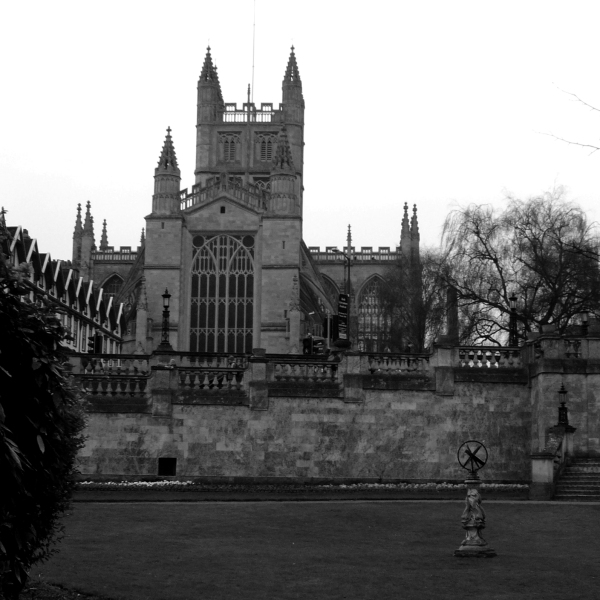
|
Each term the LU London Centre provides a one-day field trip for the students. Most often this trip is to the midlands for Warwick and Stratford-upon-Avon. For the winter term, however, the lack of suitable plays in Stratford led us to make an alternative trip to the west country, visiting Bristol and Bath. On the way to Bristol we strayed a bit to the south to stop at Stonehenge. 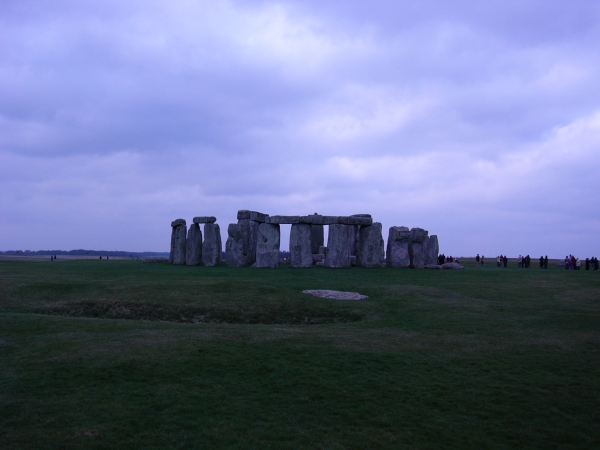 Though this picture
doesn't require a caption, I'll let you know that it is, in fact,
Stonehenge.
I don't have much to say about Stonehenge. I hate to say it, but it was a slightly disappointing visit for me. Quite frankly, the stones look a bit better in photos than they do in real life. Add to that the fact that it was quite chilly that day with cold winds blowing off Salisbury Plain leaving the entire group--we were all unprepared for the cold weather having been spoiled by the relative shelter of London--completely freezing. I think I listened to the first four or five minutes of the audio guide ("While we don't know anything what-so-ever about how these monoliths were cut, moved, or placed or, for that matter, what they were used for, we can make thousands of long-winded surmises while playing dramatic music in the background...") before deciding I'd prefer to keep my hands warm in my pockets rather than listen to a deep English voice muse about our pre-historical ignorance. But I'm being too tough on Stonehenge, I think: it really is an interesting place, though I think you'd be hard pressed to spend more than maybe an hour there. It would certainly make for a better side visit than a final destination. After our brief stop at Stonehenge (much of which was admittedly spent warming up in the crowded gift shop), our coach driver drove us to Bristol by way of some very charming country roads. While I found the journey to be very pleasant, several of the students found taking winding country roads at great speed in a large coach to be a bit unsettling to the stomach. Suffice it to say the scenery was better outside of the coach than in. Our time in Bristol was pretty much completely taken up by our visit to the relatively new British Empire and Commonwealth Museum. The museum features an excellent and diverse collection matched by admirable curation--well worth a visit if you find yourself in Bristol. As our time in Bristol was short, I didn't have a chance to take any pictures. I was very impressed by what parts of the city I did see, though, and have promised myself to visit again soon if I can manage it. Our final destination of the day was Bath where we had tickets to see The Importance of Being Earnest at the Theatre Royal. A strange thing happened to me during the performance: my voice, which had been only very slightly hoarse earlier that day, completely went during the first fifteen minutes of the play. Early in the first act I went to laugh--it was, in my opinion, an excellent production--and not a sound came out my mouth. It was thoroughly disconcerting. After the play the majority of the group loaded onto the coach to head back to London. Myself along with two friends (Becky and Sarah) checked into hostel we had booked so that we could spend some further time in Bath. We found the staff at the Bath Backpacker's Hostel to be very friendly, but we were a bit put off to find that the triple room we had booked was neither clean nor really a triple. After quickly cleaning our room (oops), the staff was quick to point out that one of the two beds was slightly wider than the other, indicating that it was supposed to provide for two of us. We were quick to point out that none of us had been particularly planning on a sharing a bed that night. In the end, we coped. (It did all seem a bit presumptuous, though.) 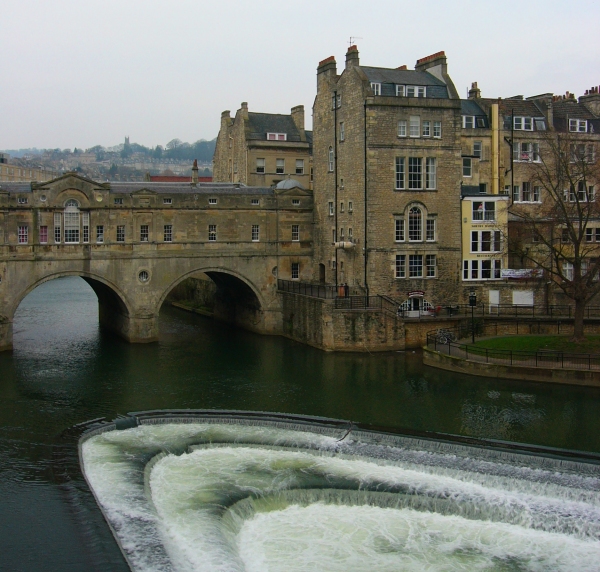 One of the most photogenic bits of a rather photogenic city: Pulteney Bridge. The next day we set about
exploring Bath, a very well-preserved Georgian (i.e. 18th century)
city. My voice, instead of getting better as I had hoped, was in
fact rather worse. I couldn't make the slightest of noises, not
even the softest hum. It was quite lucky that I wasn't alone as I
would have found it very difficult to enjoy the city without
assistance. As it was, Becky and Sarah acted as my impromptu
interpreters usually repeating my whispers loud enough for waiter,
cashier, or pharmacist (as the case might be) to hear.
Our first stop of the day was to visit the famous Roman Baths that give the city its name. Though the original baths date back to the first century AD when the Romans first utilized the surprisingly hot spring water to make a semi-religious spa dedicated to the goddess Sulis Minerva, the buildings that currently surround the site date back only to Victorian times. I attempted to pay for my admission unassisted, using my hands to signal that I wanted on student ticket. The woman at the cash register understood exactly what I wanted but then, as she was about offer me an audio guide, hesitated and got rather flustered before blurting out awkwardly, "Can you HEAR?!?" I nodded furiously. The baths are an expensive attraction, but well worth a visit. The site is fascinating and they have some excellent items in the accompanying museum. As you leave you have the opportunity to purchase a glass of the (thankfully filtered) spring water from a man in a 18th century wig and costume in the elegant Pump Room. They charge you 50 pence for the glass and the water is as memorable as promised: sulfurous and served well above room temperature. And, despite being prescribed for dozens of different ailments by Georgian doctors, I can personally attest to its complete ineffectiveness when it comes to laryngitis. (Did I mention it tasted really nasty?) Later in the day we visited Bath Abbey, a large and graceful church in the centre of the city. Though the church has no admission charge, to get in you must walk past an rather somber vicar who stands over a large donation plate looking extremely expectant. A sign nearby strongly suggests a £3 donation. As I didn't have a voice with which to explain that I am but a poor and humble youth, I didn't think I had much chance of getting past him without at least slight injury to my immortal soul. Had I had any voice, the clank of three pound coins would have been accompanied by a long and sorrowful sigh. 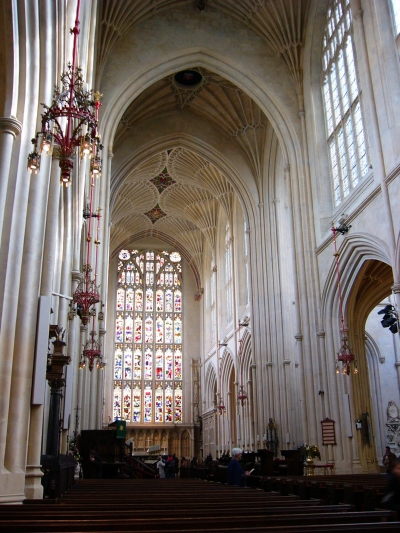 The nave and
choir of Bath Abbey.
There's not terribly much to say
about Bath Abbey except that it is brighter than most churches of its
age and styling and that it has some excellent fan vaulting. Was
it worth three pounds? [Imagine grumbling here.]
We finished up the day with a trip to the Bath Jane Austen Centre and a pleasant walk around the city. The Austen Centre is quite nice, if very small. They do a good job giving you an introductory talk about Jane's life and times, though they have to grudgingly admit that Austen was miserable for most of the time she lived in Bath. The city is generally very pretty with its uniform period architecture, though at times it seems like that one colour of grey stone is a bit overwhelming. I have heard several time the complaint that the city is, in fact, too well preserved and I think there may indeed be something to that--it seems that the preservation has come at a high price as parts of the city occasionally feel more like a museum or a movie set than a place where people actually live. A pleasant and pretty place none-the-less. |
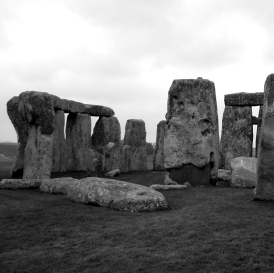 A closer view of everyone's favorite big rocks. 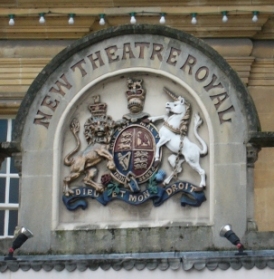 The sign for the Theatre Royal Bath. I have no idea what happened to the old theatre. 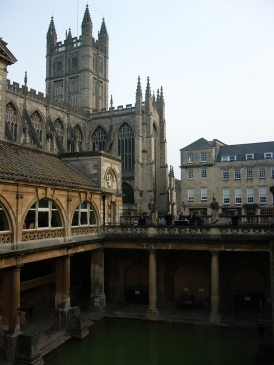 A view of the roman baths with Bath Abbey in the background. 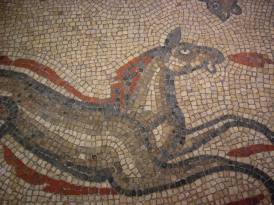 A roman mosaic in the museum at the Roman Baths. 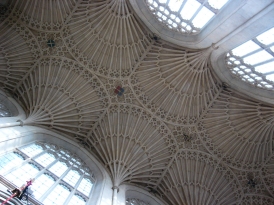 Fan vaulting in Bath Abbey. 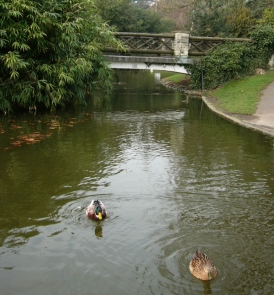 Friendly fowl in the Royal Victoria Park, Bath. 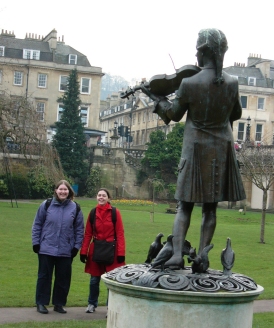 My traveling companions, Becky Passick and Sarah Mortenson, gaze at a statue of a young W. A. Mozart. |
